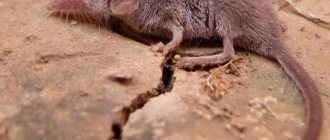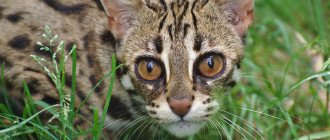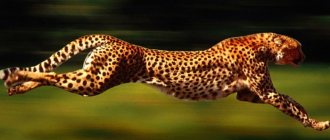This term has other meanings, see Cheetah (meanings).
| Cheetah | ||
| Cheetah in Kruger National Park, South Africa | ||
| Scientific classification | ||
| intermediate ranks Domain: | Eukaryotes | |
| Kingdom: | Animals |
| Sub-kingdom: | Eumetazoans |
| Without rank: | Bilaterally symmetrical |
| Without rank: | Deuterostomes |
| Type: | Chordata |
| Subtype: | Vertebrates |
| Infratype: | Ghostostomes |
| Superclass: | Quadrupeds |
| Class: | Mammals |
| Subclass: | Animals |
| Infraclass: | Placental |
| Superorder: | Laurasiotherium |
| Squad: | Predatory |
| Suborder: | Felidae |
| Family: | Felines |
| Subfamily: | Small cats |
| Genus: | Cheetahs |
| View: | Cheetah |
Schreber, 1775
RangeConservation statusVulnerable species IUCN 3.1 Vulnerable: 219
| NCBI | 32536 |
| EOL | 328680 |
| 224065 |
Cheetah
(old. hunting leopard; lat. Acinonyx jubatus) is a predatory mammal of the cat family, lives in most countries of Africa, as well as in the Middle East.
It is the only modern extant member of the genus Acinonyx
. The fastest of all land mammals: in 3 seconds it can reach speeds of up to 110 km/h[1][2][3][4][5][6]. According to other data, the maximum speed of cheetahs reaches 93 km/h[7][8].
Appearance
Noticeably different from other cats. The body is slender, with developed muscles and practically no fat deposits, it even seems fragile. The cheetah has a small head, high-set eyes and small rounded ears - that is, an aerodynamic body structure, which serves for better streamlining during high-speed running. The cheetah also has a large chest and lungs, which also facilitates intense breathing during high-speed running. The color is sandy-yellow, with small black spots scattered throughout the body, and thin black stripes on the sides of the muzzle. The weight of an adult cheetah is from 40 to 65 kg, body length is from 115 to 140 cm, a rather massive tail is up to 80 cm long. The height at the withers is on average from 75 to 90 centimeters.
The claws are partially retractable, which is not typical for most felines and, apart from the cheetah, is observed only in the fishing cat, Sumatran and Iriomotean cats.
Reproduction
In order for the female to begin ovulation, the male has to pursue the female for some time. Males unite in small groups, usually consisting of brothers. These groups fight with other cheetahs for hunting territory and the females within it. Male cheetahs usually hold a territory for six months together, and for three years - for 2 years. There is no territorial behavior observed in female cheetahs.
Pregnancy in cheetahs lasts 85-95 days, and from two to six kittens are born. Cheetah cubs, like any cat, are small and defenseless - easy prey for any predator, including eagles. But thanks to the dark abdomen and white or gray fluffy “cape”, predators can accept [ source not specified 1048 days
] a cheetah cub for a honey badger - a ferocious predator that fearlessly attacks any other predator. The mane on the back of the neck and the tuft on the tail of the cubs, which help the female to find kittens in the bushes, disappear by three months. The female feeds the cubs until they are eight months old. Kittens remain with their mother for 13 to 20 months. In the wild, cheetahs live on average up to 20 (sometimes up to 25) years, in zoos - much longer, which is apparently due to high-quality food and the availability of medical care.
The difficulties of cheetahs breeding in captivity are associated with their social organization and conditions of detention.
Females are solitary (except for the time they spend with their young), while males live either alone or in coalitions (Schaller, 1972). To create a population that breeds effectively in captivity (Olney, 2005), it was recommended to keep cheetahs in accordance with their natural social organization, but so far, cheetah breeding in captivity occurs irregularly, which many researchers attribute to unsatisfactory conditions for these animals, including with their behavior (Sago, 1994; Munson et al., 2005). Increasing the possibility of breeding cheetahs in captivity can be facilitated, on the one hand, by modeling (reproducing) in captivity the most important properties of the species’ natural habitat based on the study of its biology in nature, and, on the other hand, by developing a service style that involves a more attentive attitude of service personnel to needs of cheetahs (Mellen, 1991), as has been shown for some species of small cats.
— [9]
Lifestyle
King cheetahs prefer to live alone. Only during the rutting season does a married couple form, which very quickly breaks up. The female is engaged in raising cubs or leads a solitary lifestyle. Males also prefer to live alone, but sometimes they can create peculiar coalitions. By the way, the cheetah belongs to the category of territorial animals. They clearly delimit their territory using urine or excrement. The area of the female's hunting territory may vary depending on the age of the offspring or the amount of food. Males most often guard one area for a short time. The royal cheetah chooses its hiding place with special care. It should be located in an open place, visible from all sides.
The female tries to make her den in a fairly open place, although you can also find it under acacia bushes and other vegetation. The lifespan of cheetahs can vary from one to two decades.
Nutrition
Cheetah Skull
Cheetahs are diurnal predators. They hunt mainly medium-sized ungulates: gazelles, impalas, wildebeests, as well as hares. A cheetah can defeat an ostrich. 87% of a cheetah's prey is Thomson's gazelle. In Asia, the cheetah's main prey was the goitered gazelle. Cheetahs usually hunt early in the morning or in the evening, when it is not very hot, but there is enough light. They navigate more by sight than by smell.
The principle of hunting
Unlike other cats, cheetahs hunt by stalking prey rather than by ambush. This is due to the fact that the natural habitat of cheetahs and their hunting objects is open terrain and, as a consequence, there is an almost complete absence of opportunities for setting up ambushes. First, they approach the chosen victim at a distance of about 10 meters (while practically not hiding), and then try to catch it in a short high-speed race. In pursuit of the victim, they reach speeds of up to 130 km/h, accelerating to 75 km/h in 2 seconds. The cheetah runs in jumps 6-8 m long, spending less than 0.5 seconds on each jump. During a sprint race, a cheetah's breathing rate increases up to 150 times per minute[10][11]. The cheetah is also capable of quickly changing the direction of its run. When running, a cheetah's claws act like spikes on its boots. A flexible spine allows you to run without almost lifting your feet off the ground and keep your head at the same height. The tail helps maintain balance when running. In the eyes, the zone of clear visibility runs as a continuous horizontal stripe, so as not to lose sight of the prey when it sharply turns to the side (sharp high-speed turns are a fairly effective and often used way for ungulates to break away from pursuit by a predator). The cheetah usually knocks down its prey with a blow from its front paw, using a claw located on the inside of the wrist, and then strangles it. The kinetic energy carried by the body of a cheetah galloping at a very high speed helps knock down an animal larger and heavier than itself. The rapid running of a cheetah lasts a maximum of twenty seconds at a distance of no more than 400 m. Such a jerk requires such a consumption of oxygen from the muscles that the intensely working heart and even the voluminous lungs of the cheetah cannot compensate. And if the prey cannot be caught within the first hundred meters, the cheetah simply stops pursuing[12]. Despite the high speed, only in approximately 50% of cases the animal pursued by a cheetah becomes its prey. In Africa, the cheetah is the weakest of the large predators. Hyenas, leopards and lions often take prey from cheetahs,[13] often taking advantage of the fact that a cheetah needs up to half an hour to rest after a high-speed chase. The cheetah eats only those animals that it has killed itself, sometimes drags its prey into the bushes to hide it from other predators, and eats it later, but more often it hunts anew each time.
The cheetah does not hide prey in reserve, unlike, for example, a leopard, and in nature there are no known cases of it returning to it. And the cheetah hardly has the slightest chance of doing this - the remains of his short meal invariably attract a lot of people who want to profit from someone else's prey.
— [14]
Description
An ordinary observer may have the impression that a cheetah is a very fragile and delicate animal: thin, agile, without a drop of subcutaneous fat, just muscles and a skeleton covered with an unusually colored skin. But in fact, the body of this cat is superbly developed and amazes with its ideality.
An adult can reach up to a meter in height and about 120 cm in length, and their approximate weight is 50 kg. The fur, relatively short and sparse, has a light yellow, sandy color, on which, along the entire surface except the belly, small dark tan marks of various shapes and sizes are scattered. This fur coat perfectly warms a cat during cold weather and saves it from overheating in extreme heat. From the light brown, golden eyes, thin, no more than half a centimeter wide, dark lines, the so-called “tear marks,” descend to the mouth. In addition to purely aesthetic purposes, these strips act as a kind of sights - they allow you to focus your gaze on the prey and protect from sunlight.
Males, unlike females, have a small mane of longer hairs on their necks. True, immediately after birth all kittens have this decoration, but at the age of 2.5 months it disappears in female cats. Above the mane, on a small head compared to the body, there are small, rounded ears, and a black nose.
Experts are confident that all cheetahs have both spatial and binocular vision. They can simultaneously track the game selected for hunting and observe what is happening around them. It is thanks to this feature that they are considered unsurpassed hunters; the living creatures they pursue have practically no chance of salvation.
Spreading
The bulk of the cheetah population is in African countries: Algeria, Angola, Benin, Botswana, Burkina Faso, Democratic Republic of the Congo, Zambia, Zimbabwe, Kenya, Mozambique, Namibia, Niger, Somalia, Sudan, Tanzania, Togo, Uganda, Chad, Central African Republic , Ethiopia and South Africa. There are not very many cheetahs left in Asia: pockets of habitat are probably preserved only in the central part of Iran[15].
Apparently, the species has completely disappeared in countries such as Afghanistan, Djibouti, Egypt, Western Sahara, Cameroon, Libya, Malawi, Mali, Mauritania, Morocco, Nigeria, Pakistan, Senegal. However, this is not completely certain[16].
Previously, cheetahs lived in Burundi, Gambia, Ghana, Guinea, Guinea-Bissau, India, Israel, Yemen, Iraq, Jordan, Kazakhstan, Qatar, Ivory Coast, Kuwait, UAE, Oman, Rwanda, Saudi Arabia, Syria, Sierra -Leon, Tajikistan, Tunisia, Turkmenistan, Uzbekistan and Eritrea, but to date their populations in these countries have been completely destroyed[16].
Reintroduced to Swaziland[16].
As of 2007, only 4,500 adult individuals remained in Africa, with the largest number recorded in Botswana - about 1,800[16].
Evolution
Cheetahs apparently nearly went extinct during the last Ice Age, going through a bottleneck. Living cheetahs are closely related, so they show signs of genetic degeneration caused by inbreeding. For example, cheetahs have a very high infant mortality rate: more than half of the cubs do not survive to one year [17].
Previously, cheetahs, due to the special structure of their body, were classified as an independent subfamily of cheetahs ( Acinonychinae
Pocock, 1917)[18], however, molecular genetic studies have revealed their close relationship with the puma genus, which is why cheetahs began to be classified as a subfamily of small cats (
Felinae
).
Subspecies
According to Krausman and Morales (2005)[19], there are currently five clearly distinguishable subspecies of cheetahs, four in Africa and one in Asia:
African subspecies:
- Acinonyx jubatus hecki (Hilzheimer, 1913): Northwestern Africa and Sahara;
- Acinonyx jubatus fearsoni (Smith, 1834): East Africa;
- Acinonyx jubatus jubatus (Schreber, 1775): South Africa;
- Acinonyx jubatus soemmerringi (Fitzinger, 1855): Northeast Africa.
Previously recognized by some zoologists as a separate subspecies Acinonyx jubatus raineyii (Heller, 1913) East Africa and subspecies Acinonyx jubatus jubatus
were compared by genetic analysis (O'Brien et al. 1987) and found to be genetically identical, despite some external differences. It is also no longer counted as a separate subspecies Acinonyx jubatus velox (Heller, 1913)[16].
Asian subspecies:
- Acinonyx jubatus venaticus (Griffith, 1821): Iran.
Asian subspecies
Main article: Asiatic cheetah
Asiatic cheetah (Acinonyx jubatus venaticus)
previously found throughout the southeast of the continent. A small population of animals (about 60 individuals) survived in sparsely populated areas of Iran[20] - in the provinces of Markazi, Fars and Khorasan, but presumably a few individuals still remained in Afghanistan and Pakistan[21]. According to experts, today there are no more than 60 cheetahs on the entire Asian continent. According to some estimates, there are only about a dozen of them. There are another 23 individuals in zoos around the world[22]. According to research by Nowell and Jackson (1996)[23], it is preserved only in Iran.
The Asian subspecies of cheetah, previously considered a separate species[24], differs slightly from the African one: it has shorter legs, a more powerful neck and thicker skin. The main reasons for the decline in this population are the decline in the number of wild ungulates and persecution by humans. Because of their hunting method, they prefer open spaces: savannas, semi-deserts, etc.
The national favorite of the Iranians is the cheetah, which lives in semi-captivity in the Miyandasht region of Northern Khorasan[25].
Animal study
A few years after this event, hunters managed to catch several similar individuals. Scientists have carefully studied them. It turned out that the royal cat was distinguished from other animals by its claws, which it did not retract. In addition, the cat leopard had a specific color. All other characteristics were similar to those of the cheetah. After their research, scientists came to the conclusion that this rare representative of the fauna is a previously unstudied species of the common cheetah (Acinonyx iubatus), whose habitat is Asia and Africa. Because of its distinctive features, the amazing animal was assigned to a separate genus. Reginald Innes, a famous British zoologist, gave it the name Acinonyx iubatus rex, which means “king cheetah” in Latin.
For a long time, scientists argued about whether the animal is a subspecies of the common cheetah or a variation of it. The main evidence that this representative of the animal world is a new variety of cheetah was its unusual color. While ordinary cheetahs have the following color: golden-yellow with small black spots, the newly studied species had black spots only on the sides (but quite large ones), and on the back they turned into a solid stripe.
Color mutations
Royal cheetah
Royal Cheetah
The Royal Cheetah is a rare mutation that differs from the normal cheetah in coloring. The coat is covered with black stripes along the back and large merging spots on the sides.
It was first discovered in 1926. At first it was believed that it was a hybrid of a cheetah and a serval, but genetic tests disproved this theory. And although the differences were only in color, the king cheetah was initially classified as a separate species ( Acinonyx rex
)[26]. Disputes about its classification continued until, in 1981, a cub with a similar coloring was born from a cheetah of normal color in South Africa. Royal cheetahs can interbreed with ordinary cheetahs, resulting in full-fledged offspring. A recessive gene is responsible for this coloration, which must be inherited from both parents, which is why this form of coloration is so rare.
Rest
There are other color variations inherent in cheetahs. Black cheetahs (a mutation called melanism) and albino cheetahs have been spotted. The skin of black cheetahs is completely black with faint spots. In his work “The Nature of East Africa,” G. F. Stoneham reported a meeting with a black cheetah in 1925 in Kenya, the Trans-Nzoia region. Vesey Fitzgerald observed a black cheetah among ordinary cheetahs. There are red cheetahs - cheetahs with a golden color and dark red spots, light yellow and yellowish-brown cheetahs with faint reddish spots. In some desert areas, cheetahs' skin color is unusually dull; perhaps this coloring made its carriers more adaptable and therefore stuck [27].
King Cheetah: Habitat
This representative of the cat family is a very rare animal. Its range is in Zimbabwe and only a few South African regions. Currently, specialists from the De Widt Cheetah Research Center, which is located in Pretoria (South Africa), are breeding this species of animal. Thanks to their work, it was possible not only to preserve, but even to slightly increase the population of the royal cheetah. Previously, their number was only 6 individuals, currently there are about 30 of them.
Cheetah and man
In the 10th-12th centuries, the princes of eastern states used cheetahs when hunting saigas. Such hunting cheetahs were called pardus
and was very much appreciated.
To care for them, there were pardusniks
(cheetahs) at the princely courts. Some cheetahs were led on leashes to hunt, others were mounted on horses behind the riders. To prevent the animals from rushing ahead in pursuit of game, the cheetahs had caps on their heads that covered the animals’ eyes. Having surrounded a herd of antelopes or deer and approached them at an acceptable distance, the hunters removed the caps from the cheetahs, freed them from the leashes, and the animals pounced on the prey. Cheetahs were trained to hold onto caught prey until hunters approached. After this, the cheetahs received a reward - the insides of the hunted antelope. A cheetah trained to hunt was considered a royal gift[28]. The high cost of hunting cheetahs is explained by the fact that they practically do not reproduce in captivity, so young representatives of this genus had to be captured for training.
What does it eat?
The main food for a cheetah is:
- gazelles;
- wildebeest calves;
- impalas;
- hares;
- goitered gazelles
At night, this predator hunts extremely rarely and prefers to be active only in the morning or at sunset, when the heat subsides and the sun's rays do not blind.
He almost never uses his sense of smell while hunting; his main weapons are sharp vision and speed. Since there is nowhere to hide in the steppe, cheetahs do not ambush them; when they see their future victim, they overtake it in several jumps, knock it down with a blow from a powerful paw and gnaw its throat. If the prey is not overtaken during the first 300 m of the chase, the pursuit stops: fast running greatly exhausts the animal, and the small volume of the lungs does not allow for a long chase.
Interesting Facts
| This section is an unordered list of various facts about the subject of the article. Please bring the information into an encyclopedic form and distribute it to the appropriate sections of the article. As decided by the Wikipedia Arbitration Committee, lists should preferably be based on secondary, aggregated authoritative sources that provide criteria for inclusion of items in the list. (May 28, 2015) |
- On June 20, 2012, an eleven-year-old female cheetah named Sarah set a new world record in the 100-meter race among animals in the United States, running this distance in 5.95 seconds. The race took place at the zoo in the American city of Cincinnati[29].
- The legendary Indian ruler of the 16th century Akbar was a passionate lover of hunting with cheetahs: the number of “greyhound cats” living at his court at the same time reached a thousand, and in total about 9,000 animals passed through his hands. And during all this time, only once a pair of royal cheetahs gave birth to offspring - although all the pets of Padishah Akbar felt great, got along well with people and were not constrained in anything. The constant catching of free cheetahs for the needs of noble hunters for many centuries was one of the reasons for the reduction in the number of the animal[12].
- These animals are mentioned in “The Tale of Igor’s Campaign”: “On the river on Kayal, darkness covered the light: the Polovtsy spread across the Russian land, like a nest of pardus” (“On the river on Kayal, darkness covered the light - the Polovtsy spread across the Russian land, like a brood of cheetahs” ).
Notes
| Portal "Biology" |
| Cheetah at Wiktionary |
| Cheetah at Wikimedia Commons |
- Sharp, N. C. (1997). "Timed running speed of a cheetah ( Acinonyx jubatus
)."
Journal of Zoology, London 241
(3): 493–494. DOI:10.1111/j.1469-7998.1997.tb04840.x. - Milton Hildebrand (1959). "Motions of Cheetah and Horse". Journal of Mammalogy 40
(4): 481–495. DOI:10.2307/1376265. Although according to Cheetah, Luke Hunter and Dave Hamman, (Struik Publishers, 2003), pp. 37-38, the cheetah's fastest recorded speed was 110 km/h. - Carwardine, Mark.
Animal Records. - New York: Sterling, 2008. - P. 43. - ISBN 978-1-4027-5623-8. - Sears, Edward S.
Running Through the Ages. - Jefferson, North Carolina: McFarland, 2001. - P. 5. - ISBN 978-0-7864-0971-6. - Smith, Roff
. Cheetah Breaks Speed Record—Beats Usain Bolt by Seconds, National Geographic Society (2 August 2012). - Speed sensation. Nature Video Collections
. BBC Nature. - Cheetah kills with acceleration, Gazeta.Ru
. Retrieved January 30, 2020. - A. M. Wilson, J. C. Lowe, K. Roskilly, P. E. Hudson, K. A. Golabek.
Locomotion dynamics of hunting in wild cheetahs // Nature. — 2013-06-12. - Vol. 498, iss. 7453. - P. 185–189. — ISSN 1476-4687. — DOI:10.1038/nature12295. - Chelysheva E. V. Ecological and biological substantiation of approaches to the conservation of the cheetah (Acinonyx jubatus) in nature and to the optimization of conditions in captivity. Author's abstract. dis. ...cand. biol. Sciences.. Archived June 22, 2012.
- Gepard.org - Facts about cheetahs. Archived from the original on August 22, 2011.
- The speed of cheetahs was measured in the wild for the first time, Lenta.ru (June 13, 2013). Retrieved June 13, 2013.
- ↑ 12
Around the world. Greyhound cat - O'Brien, S., D. Wildt, M. Bush (1986). "The Cheetah in Genetic Peril". Scientific American 254
: 68–76. - Elena Vladislavovna Chelysheva – Running for Survival | Magazine | In the world of animals 2011- N 5
- Range map - IUCN
- ↑ 1 2 3 4 5 Acinonyx jubatus
(English).
The IUCN Red List of Threatened Species
. - Akimushkin I.I.
Skorokhod on “spikes” // Animal World. Mammals or animals. — 3rd ed. - M.: Mysl, 1994. - P. 130. - 445[1] p. — ISBN 5-244-00740-8. - Acinonychinae (English) according to the Integrated Taxonomic Information Service (ITIS).
- Mammalian Species Number 771, pg(s): 1-6, Krausman and Morales "Acinonyx jubatus", Published by: American Society of Mammalogists, July 2005.
- Asiatic cheetahs caught on camera
- A family of Asiatic cheetahs photographed in Iran
- What animals are listed in the Red Book of the International Union for Conservation of Nature
- Nowell & Jackson, Cheetah on Africa and SW Asia (1996)
- Chita, animals // Encyclopedic Dictionary of Brockhaus and Efron: in 86 volumes (82 volumes and 4 additional). - St. Petersburg, 1890-1907.
- “Iranian cheetah in a state of semi-captivity” - information on the website “Mehrnews.com”
- BigCats.com - All Those Spotted Cats Look Alike. Archived from the original on August 22, 2011.
- BIGCATS.RU - Mutations in cheetahs. Archived from the original on August 22, 2011.
- I. Akimushkin - Animal Life, 1971
- Stephanie Pappas.
Wow! 11-year-old cheetah breaks land speed record. LiveScience (3 August 2012). Archived from the original on February 1, 2013.
Enemies of the cheetah in the natural environment
In fact, in natural conditions, animals have quite a lot of abusers. The main enemies of the royal cheetah are striped hyenas (large in size), leopards, and lions. All these predators can not only take food away from animals, but also quite often destroy young animals and even adults. But still, the main enemy of the royal cheetah remains man. People destroy the predator because of its beautiful, unique fur, which is used to make clothing or interior items.
The small number of animals is also explained by the fact that inbreeding (closely related mating) often occurs. For this reason, offspring are born with defects. In addition, a pair of cheetahs with a special gene is quite rare.
The royal cheetah is one of the animals listed in the International Red Book.











